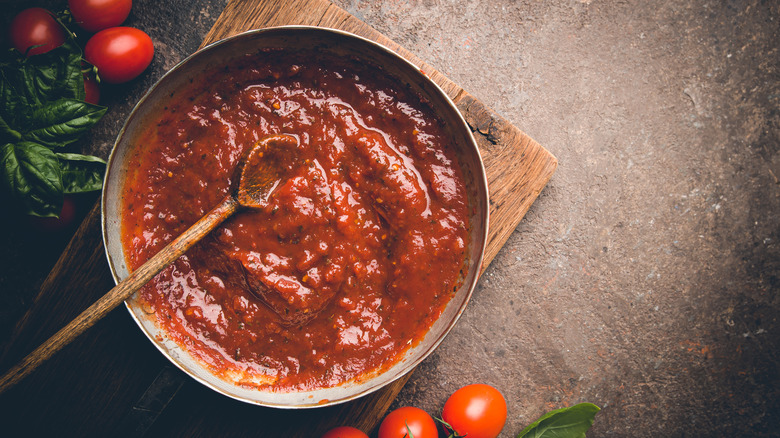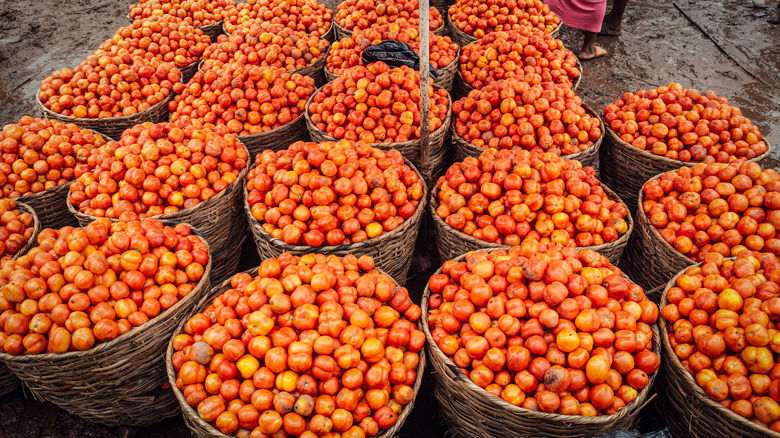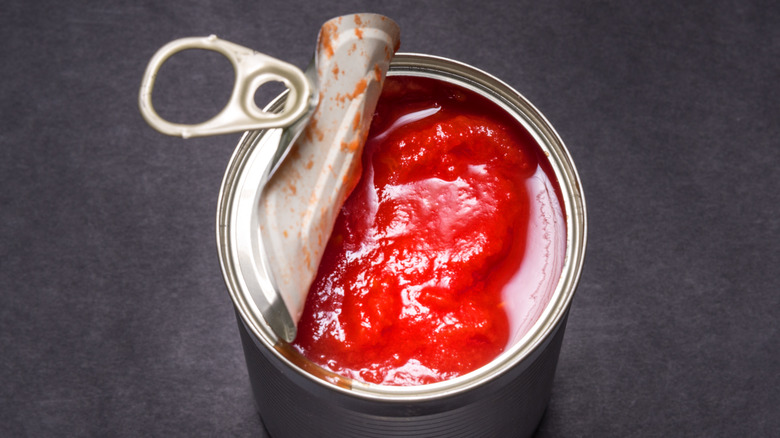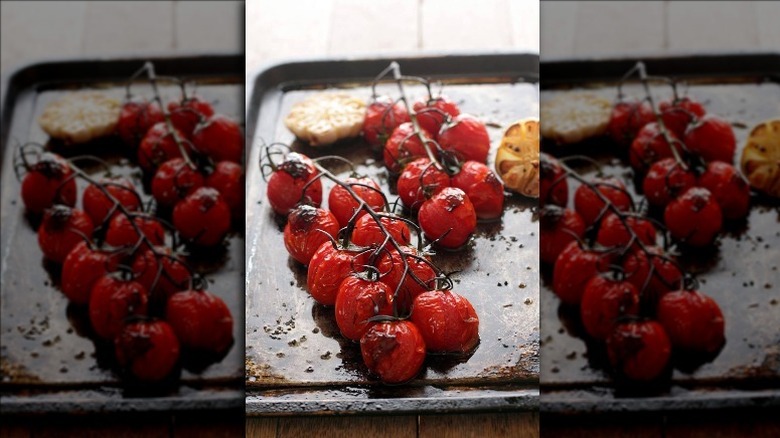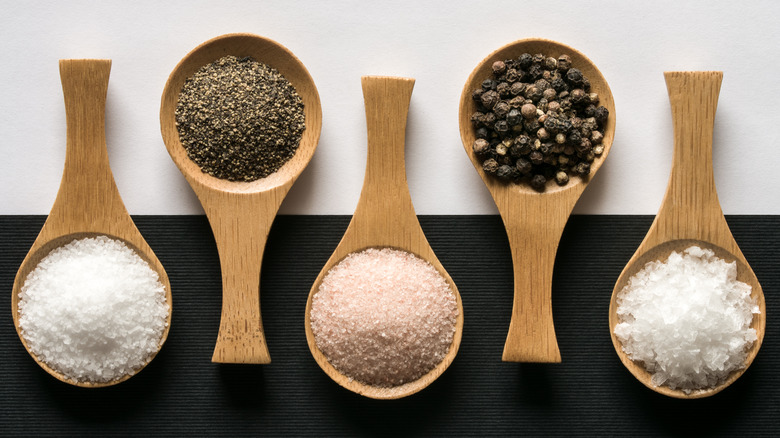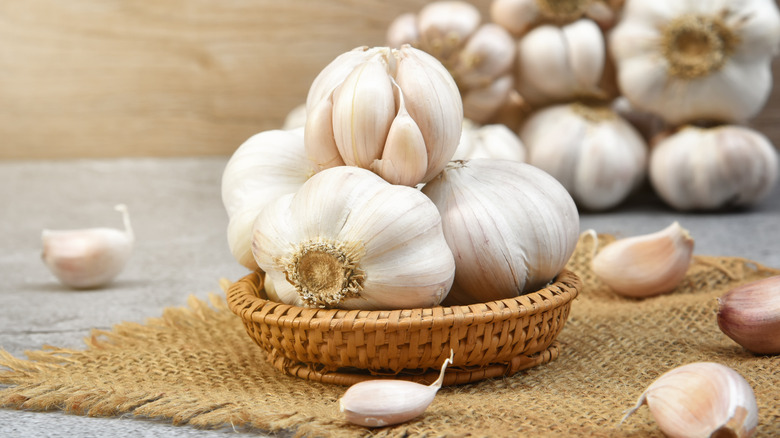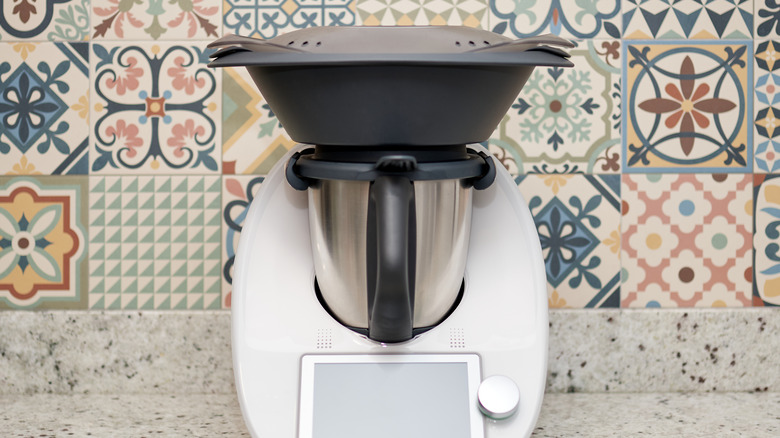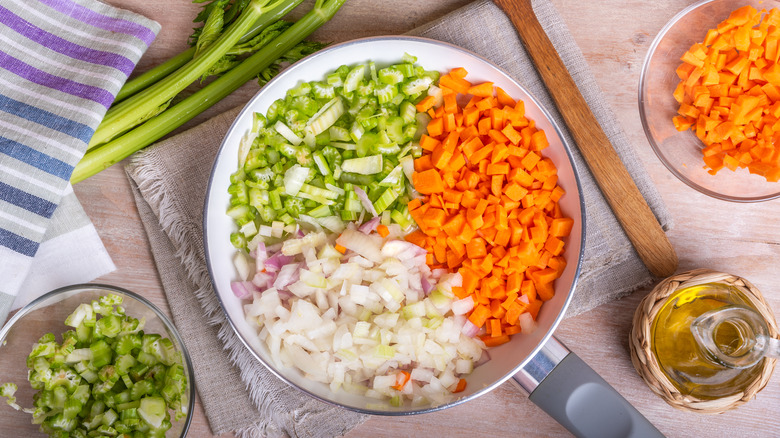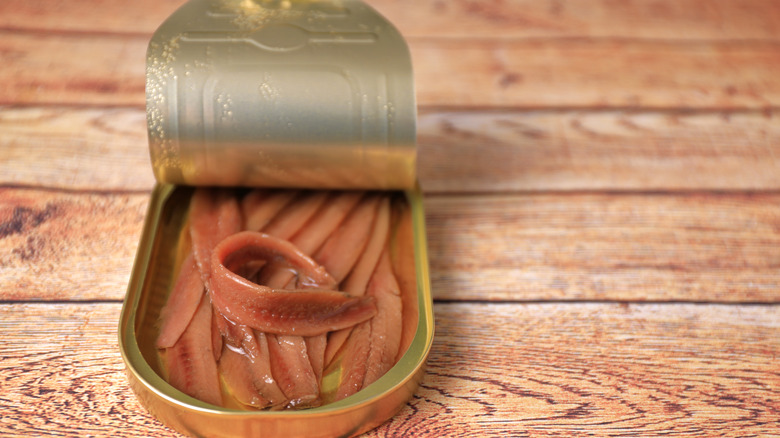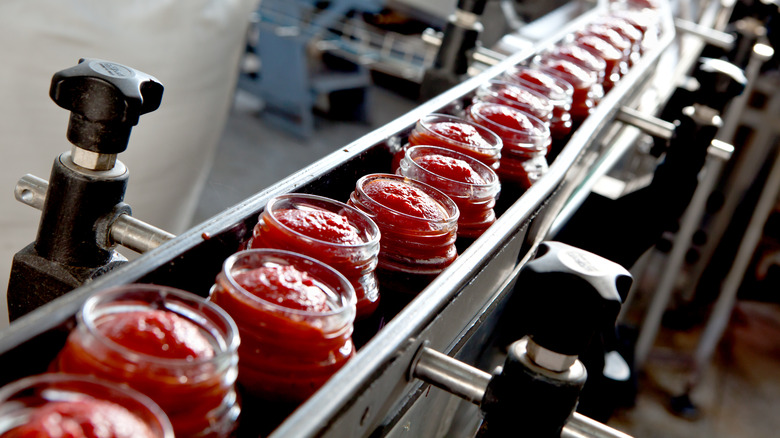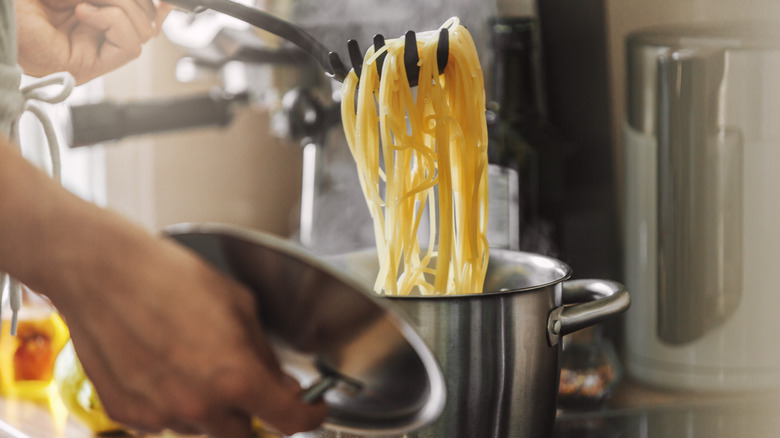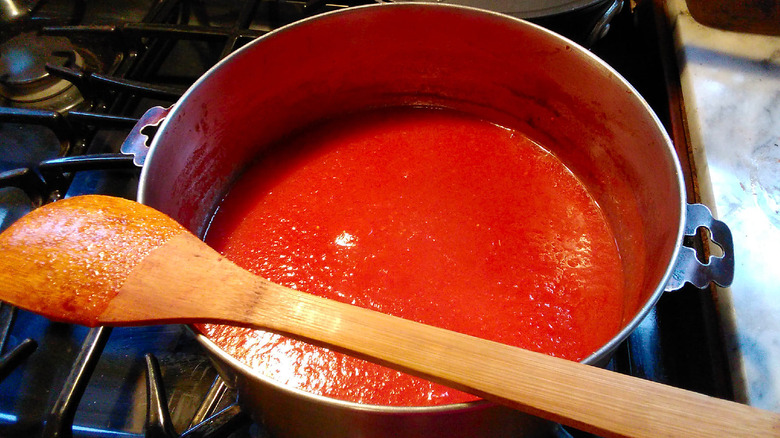Mistakes You're Making With Your Homemade Tomato Sauce
Making pasta, a pizza, or anything else that requires a red, savory, and slightly sweet sauce on top? If so, you probably already know that there are a myriad of sauces you can choose from in the grocery store. But here's the thing: You could make a much better, more inexpensive sauce if you were just to whip out the saucepan and make some of your own at home. Whether you're making a marinara or more of a plain tomato sauce, it's actually incredibly easy to do. And if it saves you money and a trip to the grocery store, how can you not want to ditch the jarred stuff?
However, if you've never made your own tomato sauce before, the process may seem a bit intimidating. There are so many ways you can go wrong, it seems. Moreover, you don't want to end up with a sad, runny, watery mess to mix in with your delicious pasta. But don't worry because, here at Mashed, we've got you covered.
We've taken a close look at some of the most common tomato sauce-making mistakes and put them all into one place. That way, you'll know what to avoid as you go about making your ideal tomato sauce. Regardless of what you're going to use your tomato sauce for, avoiding these mistakes will get you on the right path to the best possible sauce. Let's take a closer look.
Not using fresh tomatoes
As you'll see below, it's not entirely necessary to use fresh tomatoes to make your tomato sauce. While it may seem like doing everything from scratch will inevitably get you to the perfect sauce, that's not always the case. However, that doesn't mean that you shouldn't use fresh tomatoes when they're readily available to you.
But that comes with a caveat. When you're picking your tomatoes out, you'll want to ask yourself a very important question: Are these tomatoes in season? Generally speaking, tomatoes are in season in the United States in the summertime, so you probably won't want to use the pale, incredibly firm tomatoes you find in the produce section in January. According to Chef Works, when tomatoes are out of season, they have a lack of flavor and a disconcertingly mealy texture to them that's going to be less than appealing on its own, let alone in a sauce. And since a sauce is mostly there for the flavor, you can see why this won't fly.
Again, we repeat: You don't have to use fresh tomatoes for your tomato sauce. In fact, you probably shouldn't if you're trying to make it in the dead of winter. But if you do choose to with fresh, make sure you're getting the freshest, most in-season stuff you can possibly get a hold of.
Being afraid to use good canned tomatoes
Let's face it: Canned goods are not too popular at the moment. With the exception of tinned fish, most people don't want to buy a ton of food that comes in a can, whether that's because of the texture of the ingredients inside or the sodium content marked on the label. And while that's understandable with some foods (nobody likes a canned green bean, right?), there are other food items that taste just as good — if not, dare we say, even better — in canned form. One of those foods? Tomatoes.
Yes, seriously. According to The Daily Meal, cooking with canned tomatoes is generally a better idea than cooking with fresh ones. That's because the flavor is oftentimes more concentrated in canned tomatoes than in fresh ones. Additionally, if you are cooking a tomato sauce in the fall or winter, you're just not going to find great, in-season tomatoes. Therefore, it makes sense to use canned instead. That way, you'll get a more consistent taste. Having some shelf-stable ingredients at the ready for your next tomato sauce craving doesn't hurt, either.
But according to Chef Works, you shouldn't just grab any can of tomatoes off the grocery store shelf. It's worth it to invest in high-quality canned tomatoes. You'll be surprised at what a difference it makes in your sauce.
Not roasting your tomatoes
Of course, you're not always going to have access to the best tomatoes around. It's an unfortunate truth, but a truth nonetheless. And if you can't find fresh ones or even a can of decently quality tomatoes, you may assume that you're all out of luck. However, there are steps you can take to make even the saddest of tomatoes palatable for a good tomato sauce. Thrillist's suggestion? Roast them! Roasting really brings the flavor out of many foods, and it'll give your tomatoes a nice sweetness and complexity that works perfectly in a good sauce.
Wondering how to roast your tomatoes to perfection? First, cut the bottoms off of your tomatoes, then brush them with some olive oil. Don't be shy here, as the olive oil will deepen the flavor even more as part of the cooking process. Then, place your oiled tomatoes under the broiler for about 20 minutes. Word to the wise: keep checking on them, as your broiler may be stronger than others and we don't want burned tomatoes.
After 20 minutes or after the tomatoes have gotten a slight char to the surface, take them out of the oven and start making your tomato sauce. Your pizza, pasta, or whatever else you're making is going to thank you for taking the time to do this extra step in the process. So will anyone who takes a bite.
Not seasoning as you go
There's one mistake that novice cooks tend to make a lot when they're in the kitchen: they often think that they don't have to add any seasoning to their dish until right before they serve it. You might believe that this would reduce the amount of sodium in your diet, so it's a good move in that respect, but we're here to tell you that you're actually going to want to season your sauce at every step in the process. According to Chef Works, that's how you start out with a nice, flavorful base.
When you throw your tomatoes in, make sure you initially season them with plenty of salt and pepper. The salt will help draw the liquid out of the tomatoes, which will help get your sauce started. It also allows those seasoning flavors to get infused into the sauce early. Allowing these to meld and cook together for the entire time your sauce is cooking will result in a more rounded, complex taste than if you just threw everything in at the very end.
Don't forget to add other seasonings that you want in your sauce as well, such as dried basil, oregano, or even some crushed red pepper for a bit of heat. And just because you start seasoning early doesn't mean you have to hold off on the end. Taste as you go and add seasonings accordingly.
Under or over-cooking your garlic
You may think that tomatoes are the most important part of a good tomato sauce. Of course, given the name of the sauce, that's not untrue. However, tomatoes aren't the only ingredient that's playing a significant role when it comes to flavoring your sauce. In fact, perhaps even more important is the allium known as garlic. Garlic packs a ton of flavor in a tiny package, but just because there's not much of it doesn't mean you shouldn't take your time preparing this ingredeint.
First of all, you're going to want to use fresh garlic, as opposed to powdered stuff. The difference in flavor and pungency really is significant. And ideally, you'll peel and chop your own garlic instead of using the pre-chopped stuff you can get in a jar at your local grocery store, which can also be a sad flavor echo of freshly peeled garlic cloves.
But really, the most important part of the process is how you cook the garlic. Of course, you don't want to burn it, so make sure you keep an eye on it when it goes into your saucepan. But don't undercook it, either, as raw or halfway-cooked garlic can be overly strong and even a bit spicy, instead of mild and a bit sweet. Therefore, Thrillist suggests making sure that the oil in your saucepan is "rippling" hot before adding in your garlic. That way, you know your garlic is going to be toasted to absolute perfection.
Using a food processor
These days, there are so many kitchen appliances that you may not even know what to do with all of them. One particularly useful appliance is a food processor, which is perfect for making all kinds of dishes, from hummus to gazpacho. And if you're used to getting your tomato sauce from a can, you may think that the food processor is the way to go when you're done cooking your sauce. After all, isn't that how they get it all creamy and smooth before they put it in the jar?
Of course, if you prefer a smoother consistency for your tomato sauce, then feel free to go ahead and blend it or put it in a food processor to achieve that texture. However, many people don't realize how good a chunky tomato sauce tastes. If you're using good-quality tomatoes (either fresh or canned), you're going to want to taste those tomatoes as much as possible, after all. Pulverizing them into pulp isn't going to do much of anything to help you out in the flavor or texture department. Therefore, we suggest skipping the food processor and keeping things a bit chunky. Try it out and see how you like it.
Adding too many extra ingredients
If you are a prolific home cook and have made your fair share of sauces in your day, then you know a lot of the most well-known sauces start with a base of carrots, onions, and celery. This trio, often known as mirepoix, creates an incredible flavor that adds the perfect touch to many dishes. However, when it comes to a good tomato sauce, things are a little different. Consider the possibility that you don't want to make things more complicated than they need to be. Therefore, Bon Appétit recommends skipping out on all those extraneous ingredients, which you generally don't need in a classic tomato sauce.
Should you still include onions and garlic in your sauce? Of course. These additions pack in a ton of flavor and aroma that you're simply not going to get any other way. But celery? No thank you. Celery adds a bitterness that doesn't belong in a tomato sauce. And we definitely don't want to see any carrots in our tomato sauce. We understand trying to get more veggies into your diet, but carrots add too much sweetness to the mix, which can upset the balance of flavors you've worked so carefully to build. Plus, who wants an orange tomato sauce?
It may be tempting to go above and beyond when you're constructing your tomato sauce, but don't go overboard. Once your sauce is done simmering, you'll be glad that you kept things simple.
Forgetting to use anchovies
Now, we know what we just said about extraneous ingredients, but that's really when we're talking about ingredients that aren't going to do much to add flavor to your sauce. However, there is one extra ingredient that you may not think of throwing in that will actually make your tomato sauce taste absolutely incredible with very little effort. That ingredient? Anchovies.
We know what you're thinking. Why would we suggest adding fish to a tomato sauce, especially one that's notoriously divisive? Wouldn't that just make it taste weird and fishy? And you probably don't want to scoop up little pieces of fish when you're just trying to eat a simple pasta dish. However, as Thrillist asserts, anchovies are actually an amazing ingredient to add to your tomato sauce. That's because they're going to pack an umami flavor punch that gives your mixture a lot of depth. It's not just for saltiness, either. These little fish add a ton of complexity and even some nutrients to the final sauce.
And the best part? You don't have to chop them up or worry about getting big pieces of fish in your dish, all because they just melt away in the pan. And, no, it won't taste fishy and your guests won't even be able to tell that you added them in. This is a super simple way to take your tomato sauce to the next level, and it's as easy as can be. Give it a try.
Trying to make your sauce in a rush
We've all been there: You come home after a long day at work or school, and all you want to do is tuck into a big bowl of pasta without having to do much work. While there's certainly a time and place for that kind of dinner, you probably won't want to make your own tomato sauce from scratch if you're trying to get the quickest meal possible. Why? Because a good tomato sauce takes time to build, and trying to pull it off in less than 30 minutes is likely to result in a disaster, per Chef Works.
Building a good tomato sauce is all about layering flavors and then allowing those flavors to meld together on the stove. While you can technically throw all the ingredients together, cook them for a few minutes, and then serve your sauce with pasta, you're probably going to be disappointed with the results. That's because your sauce is likely to come out bland and watery, given that you didn't allow time for those flavors to mix and mingle. You want your tomatoes to taste sweet and rich, after all, and not like you just opened a can of crushed tomatoes and added them to some cooked pasta out of the blue.
There's a time and a place for making your own tomato sauce — and when you're tired or in a rush, you're generally better off just using the jarred stuff.
Not using pasta water in your tomato sauce
Now, we know that not all tomato sauce is destined to make its way into a pasta dish — but a lot of it is. And if you're planning on adding your tomato sauce to pasta, then there's one extra step you don't want to forget to take. First of all, you never want to keep your pasta and the tomato sauce separate until you serve. Rather, it's better to cook your pasta almost all the way in the water, then add it to the sauce to continue cooking for the last few minutes. That helps the sauce work its way into the crevices of the pasta and results in a much more cohesive flavor.
However, when you get ready to drain your pasta so you can add it to the tomato sauce, don't forget to reserve some of the pasta water, too. Why? Because you can add it back into your tomato sauce to make it extra creamy, thick, and velvety. That water is actually full of starch from the pasta, which will serve as a thickener for sauce and can seriously take it to the next level. Give it a try if you want to impress all of your guests with your pasta and sauce-cooking skills.
Cooking your sauce for too long
While you certainly don't want to be in a rush when you're cooking your tomato sauce and end up undercooking it, you're also going to want to avoid cooking your sauce for too long. That's because, while you want all those amazing flavors to mix with each other, you don't want to overcook everything to the point that it completely loses its flavor. Remember, a good tomato sauce tastes nice and fresh. If you cook your sauce for too long, you're likely to lose some of that freshness and dull down your flavors considerably.
Additionally, if you prefer your tomato sauce on the chunkier side, there's a good chance that you'll also lose some of that texture you love if you overcook your sauce. Therefore, you shouldn't let it simmer away on the stove forever.
Your best bet? Follow a recipe, at least the first few times, and don't leave your sauce cooking on the stove for longer than that recipe tells you to do. That way, you know you'll get the best-tasting tomato sauce possible.
Forgetting to taste the sauce regularly as you cook
We get that, when you're making dinner, you're often pretty busy. On many occasions, it seems like there are a hundred things you have to do before you can finally put a meal on the table. With all that going on, it can be easy to forget one of the most important steps in any cooking process, according to Thrillist: taste-testing the dish. Even if you've made the same tomato sauce a hundred times, you'll always want to know that you're on the right track while you're cooking. That's why you should taste as you go. This will inform you about whether you've added enough salt, pepper, or other seasonings.
This means that, if you wait until the end of the cooking time to taste your sauce, you won't be able to fix those layering issues. And, frankly, adding in a ton of salt at the end is not going to produce the same depth of flavor as building up that salt content as you go. The same goes for practically any other seasoning, too.
So grab yourself a glass of wine, put on some relaxing music, and really enjoy yourself as you cook your tomato sauce, always remembering to taste as you go. You may just be pleasantly surprised by the results.
